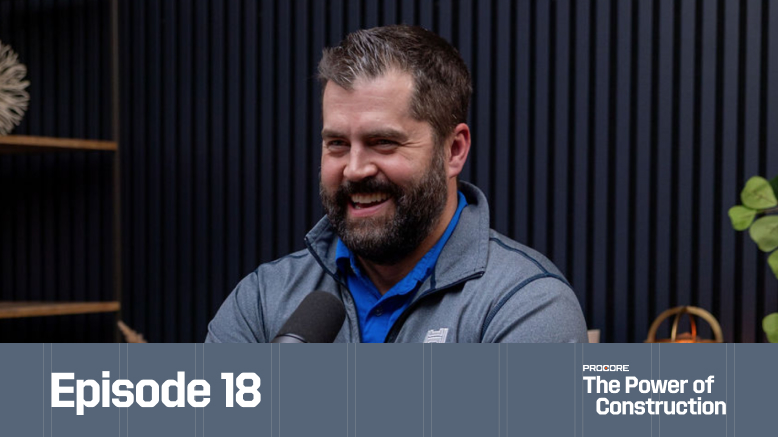Welcome & Framing the Real AI Debate
Brett King welcomes listeners to The Power of Construction, recording live at Groundbreak, and explains that he is filling in for the usual hosts Sasha Reed and Kris Lengieza. He frames the central questions of the episode around AI in construction: who owns the intelligence AI creates, whose data powers it, and who is responsible when AI is wrong.
Brett introduces his guest, Hugh Seaton, CEO of The Link.ai, author of The Construction Technology Handbook, and host of the Constructed Futures podcast. Together they set the tone for a conversation that looks beyond AI hype to the practical realities of governance, ownership, and trust in construction data.
Why AI Governance Is the New Battleground
Hugh explains that AI introduces a new layer of governance that goes beyond traditional cybersecurity and access control. With generative AI, organizations now have to govern not only where data lives but also what content AI produces and who can see it.
He introduces the idea of context engineering as the core discipline behind making agents and chatbots work well, describing how guardrails around input data and system prompts define what AI can and cannot do.
Hugh shares an early example of a chatbot connected to email that exposed salary information because no one had considered that AI could read everyone's emails quickly. This illustrates how AI opens up new risks alongside new potential, and why governance must include rules about what AI should and shouldn't answer.
Evals & Guardrails: Ensuring AI Outputs Are Right
Hugh emphasizes that testing AI systems requires a new approach called evaluations or evals. Unlike traditional software testing where engineers verify that the pipes work, AI testing requires subject matter experts from the field to evaluate whether outputs are appropriate and correct.
He provides an example of duct installation, where a 700-page reference book contains numerous methods that are "almost right." Without proper governance and context clarification, an AI might provide one of 30 answers that are nearly correct but not quite appropriate for the specific situation.
This highlights the importance of having actual users and domain experts involved in evaluating AI systems, not just software engineers.
Who Owns the Data on Today's Jobsites?
Brett asks the critical question: when data flows into shared systems, who actually owns it? Hugh explains that ownership comes down to contracts, not established legal precedent. The data contractors and subcontractors produce has value it didn't have five or ten years ago, making this a negotiable factor in contract discussions.
Hugh suggests that while contractors probably won't win arguments about owning design data, they should own the outputs their teams produce. He introduces licensing structures as a practical solution where contractors retain ownership but grant owners perpetual licenses to use the data in certain ways.
He encourages construction professionals to consult with IP lawyers, noting that IP lawyers tend to be more business-focused than other attorneys and can help structure agreements that protect everyone's interests while enabling data sharing.
From Data Chaos to Data Quality & Structure
Hugh acknowledges the "Wild West" state of construction data and explains that the industry is working to bring structure through standardized data entry methods. He emphasizes that organizing data starts with how it's entered and continues through how it's stored and accessed.
He discusses the evolution from "data lakes" to more organized storage solutions, noting that being thoughtful about the chain from data creation to data access is essential. The key question is whether you need quantitative analysis (requiring consistent formats and labels) or qualitative summaries using generative AI.
Hugh suggests that for tasks done frequently, quantitative analysis provides statistical insights, while for more ad hoc or conversational needs, AI-powered summarization can be effective.
Should We Collect All Data—or Only What We Need?
Brett shares a debate from a recent panel about whether to collect all possible data or only what's needed immediately. Hugh responds with the perspective of facilities managers who get overwhelmed with terabytes of irrelevant data at project closeout.
He argues against the "collect everything" mentality from the big data era, emphasizing that construction teams need to ask what they'll actually do with the data. Operating teams and contractors should think three to five years ahead and identify where they'll genuinely use data analysis.
Hugh suggests creating categories of "definitely will use," "maybe will use," and "might use if we have resources" to define a finite, manageable universe of data collection rather than trying to capture everything.
The Hidden Cost of Storing vs. Organizing Data
While Brett mentions the storage costs of keeping data, Hugh points out that the bigger challenge is organizing data properly. Simply dumping data into storage isn't sufficient—it needs to be structured so it can be accessed and analyzed effectively.
This organization typically requires external expertise, as most contractors don't have data scientists on staff. Hugh emphasizes that being realistic about what you're going to do with data is important, which is why some people become cynical about technology promises—the implementation and ongoing work required is substantial.
Protecting "Secret Sauce" & Knowledge Transfer with AI
Hugh draws on his experience in advertising to address concerns about protecting competitive advantages. He suggests that "secret sauce" really comes down to people—who you hire, train, nurture, and empower to do their best work.
Rather than worrying about losing competitive advantages, Hugh recommends focusing on enabling your secret sauce. This means capturing the knowledge of experienced professionals (like the 45- or 50-year-old who really knows a building type) in ways that can be transmitted to others.
While you can't transmit judgment or the secret sauce in someone's mind, you can document lessons learned through structured interviews tied to specifications or project types. AI can help organize these lessons and surface them when relevant, making institutional knowledge accessible without requiring people to read lengthy manuals.
Open vs. Ring-Fenced AI: Where Should Your Data Live?
Brett raises the question of whether to use open AI systems like ChatGPT or ring-fenced, private environments. Hugh has a strong view: with modern AI models being so capable, you don't need top-of-the-line models for 99% of tasks, and you can host models privately on platforms like Amazon, Azure, or Google.
He recommends starting with open models like ChatGPT (with data sharing turned off) to learn and identify use cases. Once you're ready for production use, transition to private hosting with proper controls. Hugh clarifies a common misconception: AI is not learning while you're using it—models are trained periodically with collected data, not in real-time during your sessions.
Hugh predicts that in the next five years, many contractors will run their own on-premises servers with GPUs, as the cost of adequate computing power becomes achievable. Private hosting is getting easier and cheaper rapidly.
Data Lineage & Trust: Proving Where Information Came From
Hugh explains that data lineage means understanding where data started, what happened to it at each point, and where it is now. This traceability is important because you want people to work with data—changing it, adding to it, transforming it—while maintaining a record of who did what.
Data lineage intersects with IP questions and provides an audit trail. While the tooling already exists in most software systems, it requires a conscious investment from company owners and IT teams to implement properly.
Hugh suggests that while data lineage may not be a litigation concern today, it could be valuable in the future for tracing back statements or claims to specific meetings or sources, adding another layer of accountability and traceability.
Should AI in Construction Be Regulated?
When asked about government regulation, Hugh firmly says no—it's too early. He argues that we don't yet know where the real risks are, and government involvement would be premature. Most construction activities are already covered by contract law for liability purposes.
Hugh praises contractors who locked down ChatGPT when it first emerged as an appropriate response to unknown risks. He recommends a measured approach: slow down, understand the technology through pilots and education (like attending Groundbreak), and learn at the ground level where real risks emerge.
The biggest current risk, according to Hugh, is people trusting AI before it's ready—particularly younger workers who used ChatGPT extensively in school and might trust it too much for critical construction tasks. AI can produce answers that look legitimate but are incomplete or lack the contextual understanding a human would automatically apply.
The Husky vs. Wolf Problem: Why AI Thinks Differently
Hugh shares a famous example from a university AI project that confused huskies and wolves. The researchers discovered the AI wasn't looking at the dogs' features at all—it was identifying them based on snow in the background of photos.
This illustrates a fundamental difference: humans focus on meaning and subjects, while AI just does statistics on data without understanding what anything means. Humans automatically notice connections and apply context; AI doesn't distinguish between foreground and background, or understand significance.
Hugh emphasizes that because AI works fundamentally differently from humans, we can't always predict where it might go wrong. This is why pilots, testing periods, and working with customer success teams make sense—to build trust incrementally and understand where the system is reliable before expanding its use.
Leader Playbook: First Steps to Prepare for AI Governance
Hugh offers practical advice for leaders: start using ChatGPT for personal tasks. Ask it about weekend plans, recipes, or hobbies—low-risk applications that let you develop intuition about where AI excels and where it falls short.
He notes that AI is often good at finding information but weak at drawing deep conclusions. Through personal use, leaders can develop the judgment needed to identify appropriate use cases in their businesses.
Hugh also recommends talking to people—most companies offering AI solutions are happy to have conversations through customer success teams or other channels. Joining forums, groups, and masterminds where peers are experimenting with AI helps leaders learn from others' experiences.
The key insight: senior leaders have good intuition and judgment for a reason. That same intuition applies to creativity with AI—identifying where it could solve problems that have been frustrating for years, not just mitigating risks.
AI as a New Resource: Unlocking Value Through Creativity
Hugh emphasizes that AI isn't a single technology but a new way of thinking and a new type of resource. Real value comes from creativity—identifying where AI can plug into existing processes and where it shouldn't be used yet.
Many unlocks will be small improvements rather than transformative changes. Hugh gives the example of RFI writing, which many people find tedious. AI can create a first draft, making it easier to be an editor than the initial writer—the "zero to one" problem becomes much simpler.
Leaders should connect their business intuition to AI possibilities, identifying use cases based on deep knowledge of how their operations work and where bottlenecks exist, not just from hearing conference presentations.
Rapid-Fire: Books, Voices to Follow & Future Trends
Recommended Books: Hugh recommends Co-Intelligence by Ethan Mollick as an accessible, pragmatic book about AI and work.
Voices to Follow: Ethan Mollick (on LinkedIn and beyond) for practical applications of AI in work, and Nate Jones (on Substack and YouTube) for staying current on what model makers are doing and understanding recent AI announcements.
Advice to Younger Self: Learn to code—not because you'll need to write code (AI can help with that), but because understanding software structure and how things work is invaluable, similar to how liberal arts teaches you to think.
Future of Construction: Hugh predicts robotics will shape construction's future, particularly for moving materials around jobsites and handling dangerous or dull tasks. While we're far from trusting robotics with precision work, logistics and materials handling will see advances. Exoskeletons may help workers stay on jobsites longer and more safely as they age.
Industry Tagline: "Don't worry, we're getting it done."





